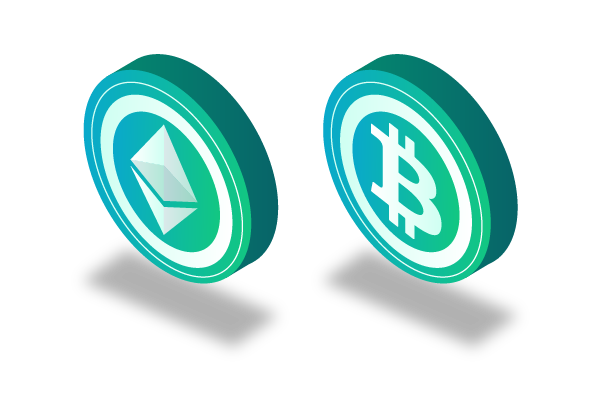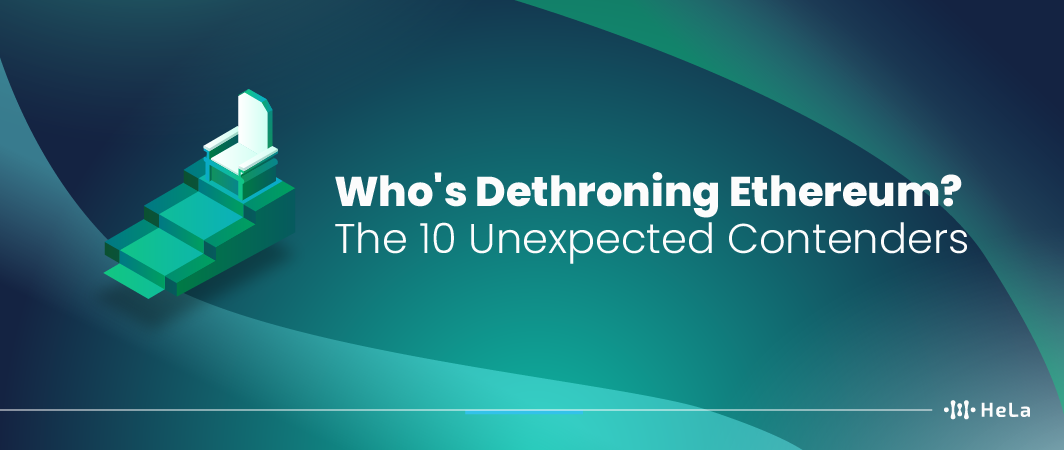As Ethereum continues to face challenges related to scalability, gas fees, and network congestion, a new wave of blockchain platforms—often dubbed “Ethereum killers”—is rapidly gaining momentum. These next-generation networks aim to outperform Ethereum by offering faster transactions, lower fees, greater energy efficiency, and more developer-friendly environments.
In 2025, the race to become the dominant smart contract platform is more competitive than ever. From modular frameworks to high-throughput chains, this article explores the top 10 Ethereum killers that are reshaping the blockchain ecosystem and pushing the boundaries of what’s possible in decentralized technology.
Bitcoin vs. Ethereum – A Comparative Perspective

Bitcoin and Ethereum both use blockchain technology, but they have distinct roles. Bitcoin acts like digital money and a way to store value, similar to gold in the digital realm. On the other hand, Ethereum functions as a platform where people can create smart contracts and build decentralized apps. Some folks might see them as rivals for investment, but in reality, they work together to make the blockchain world go round.
Now, there’s a term thrown around in the crypto world called the “Ethereum killer.” This refers to new projects aiming to outdo Ethereum’s capabilities. While these competitors pop up now and then, Ethereum remains a significant player, and it’s more about complementing than killing off. So, in the big picture, Bitcoin and Ethereum are like two essential pieces of the blockchain puzzle, each with its own unique role, working together to advance the whole ecosystem.
Top 10 Ethereum Killers To Consider in 2025

Ethereum has long been the dominant force in the smart contract platform arena. However, as we move into 2025, several emerging blockchain platforms are positioning themselves as strong contenders, often referred to as “Ethereum killers.” These platforms aim to address Ethereum’s limitations, such as scalability and high transaction fees, by offering innovative solutions. Among these contenders are HeLa and BNB Chain, both of which have made significant strides in recent years.
1. HeLa
HeLa is an innovative blockchain platform that emphasizes modularity, scalability, and interoperability. By separating consensus, execution, and data availability layers, HeLa offers a flexible architecture that can adapt to various use cases.
Key Features:
Modular Architecture: Allows for independent upgrades and customization of each layer, enhancing scalability and flexibility.
High Throughput: Capable of processing a large number of transactions per second, making it suitable for high-demand applications.
Interoperability: Designed to seamlessly interact with other blockchain networks, facilitating cross-chain transactions and collaborations.
Developer-Friendly: Provides comprehensive tools and SDKs to simplify the development of decentralized applications (dApps).
Why HeLa Stands Out:
HeLa’s emphasis on modularity and interoperability positions it as a versatile platform capable of supporting a wide range of applications, from decentralized finance (DeFi) to supply chain management. Its scalable architecture ensures that it can handle increasing demand without compromising performance.
2. BNB Chain (Binance Smart Chain)
BNB Chain, formerly known as Binance Smart Chain, is a blockchain platform developed by Binance, one of the world’s largest cryptocurrency exchanges. It aims to provide a high-speed, low-cost alternative to Ethereum, with a focus on supporting dApps and DeFi projects.
Key Features:
High Throughput: Capable of processing up to 100 million transactions per day, ensuring scalability for large-scale applications.
Low Transaction Fees: Offers significantly lower fees compared to Ethereum, making it more accessible for users and developers.
EVM Compatibility: Supports the Ethereum Virtual Machine, allowing for easy migration of dApps from Ethereum.
Robust Ecosystem: Hosts a wide array of dApps, DeFi platforms, and NFT projects, contributing to its growing user base
Recent Developments:
In 2025, BNB Chain introduced several upgrades to enhance its performance and user experience:
Sub-Second Block Finality: Reduced block confirmation times to under one second, improving transaction speed.
Gasless Transactions: Implemented a system allowing users to pay transaction fees with BEP-20 tokens or stablecoins, enhancing flexibility.
AI-Driven Smart Wallets: Launched wallets with AI capabilities to assist users in managing their assets and transactions more efficiently.
Why BNB Chain Stands Out:
Backed by Binance’s extensive resources and user base, BNB Chain offers a compelling combination of speed, affordability, and a thriving ecosystem. Its continuous upgrades and commitment to user experience make it a formidable competitor in the blockchain space.
3. Solana (SOL)
Solana is known for its high throughput and low latency, making it an attractive platform for dApps and DeFi projects. Its unique consensus mechanism, Proof of History (PoH), enables rapid transaction processing.
Key Features:
High Throughput: Capable of processing thousands of transactions per second.
Low Fees: Offers minimal transaction costs, enhancing user accessibility.
Growing Ecosystem: Hosts a variety of dApps, NFT platforms, and DeFi projects.
Why Solana Stands Out:
Solana’s emphasis on speed and low costs makes it a preferred choice for developers seeking to build scalable applications without the constraints of high fees and slow transaction times.
4. Polkadot (DOT)
Polkadot is designed to facilitate communication and interoperability between different blockchains. Its unique architecture allows for the transfer of data and assets across various networks.
Key Features:
Parachains: Independent blockchains that run in parallel within the Polkadot ecosystem.
Interoperability: Enables seamless interaction between different blockchain networks.
Scalability: Supports multiple blockchains, enhancing overall network throughput.
Why Polkadot Stands Out:
By focusing on interoperability, Polkadot addresses one of the key challenges in the blockchain space, paving the way for a more connected and versatile ecosystem.
5. Avalanche (AVAX)
Avalanche offers a highly scalable and customizable platform for dApps and enterprise blockchain deployments. Its consensus protocol enables quick finality and high throughput.
Key Features:
High Throughput: Processes thousands of transactions per second.
Customizable Subnets: Allows for the creation of tailored blockchain networks.
Interoperability: Supports cross-chain communication and asset transfers.
Why Avalanche Stands Out:
Avalanche’s flexibility and performance make it suitable for a wide range of applications, from DeFi to enterprise solutions, offering developers the tools to build scalable and efficient platforms.
6. Cardano (ADA)
Cardano emphasizes a scientific and research-based approach to blockchain technology, aiming to provide a secure and scalable platform for smart contracts and dApps.
Key Features:
Ouroboros Consensus: A proof-of-stake protocol designed for security and energy efficiency.
Formal Verification: Utilizes mathematical proofs to ensure the correctness of smart contracts.
Scalability: Designed to handle a high volume of transactions with low fees.
Why Cardano Stands Out:
Cardano’s commitment to academic rigor and formal methods sets it apart, aiming to provide a robust and secure foundation for decentralized applications.
7. Algorand (ALGO)
Algorand focuses on delivering fast, secure, and scalable blockchain solutions, particularly for financial applications and decentralized finance.
Key Features:
Pure Proof-of-Stake: Ensures decentralization and security.
Fast Transactions: Offers quick finality and low transaction fees.
Smart Contracts: Supports complex dApps and financial instruments.
Why Algorand Stands Out:
Algorand’s emphasis on performance and its suitability for financial applications make it a strong contender in the blockchain space, particularly for institutions seeking reliable solutions.
8. Tezos (XTZ)
Tezos is a blockchain platform that can upgrade itself without the need for hard forks, ensuring adaptability and long-term sustainability.
Key Features:
On-Chain Governance: Allows stakeholders to vote on protocol upgrades.
Formal Verification: Ensures the correctness of smart contracts.
Energy Efficiency: Utilizes a proof-of-stake consensus mechanism.
Why Tezos Stands Out:
Tezos’ self-amending capability and governance model provide a flexible and sustainable approach to blockchain development, accommodating evolving needs without disruptive changes.
9. Fantom (FTM)
Fantom employs a Directed Acyclic Graph (DAG) architecture to deliver high-speed and scalable blockchain solutions, particularly for DeFi applications.
Key Features:
Lachesis Consensus: An asynchronous Byzantine Fault Tolerant protocol for fast and secure transactions.
High Throughput: Capable of processing thousands of transactions per second.
Low Fees: Offers cost-effective transaction processing.
Why Fantom Stands Out:
Fantom’s unique architecture and focus on performance make it an attractive platform for developers seeking to build efficient and scalable decentralized applications.
10. Injective (INJ)
Injective is a blockchain platform tailored for decentralized finance, offering advanced features such as on-chain order books and cross-chain derivatives trading.
Key Features:
High Performance: Processes transactions with sub-second finality.
Interoperability: Supports cross-chain asset transfers and trading.
**DeFi Capabilities
Challenges for Ethereum Killer

While these emerging platforms offer innovative solutions and features, they also face a myriad of challenges in their quest to rival Ethereum:
1. Adoption Rate
Ethereum’s vast developer community and plethora of dApps give it a significant advantage. New platforms must incentivize developers to build on their networks and attract users to their ecosystems.
2. Interoperability
As the crypto space grows, the ability for different blockchains to communicate seamlessly becomes crucial. Platforms like HeLa and Polkadot are already addressing this, but it remains a challenge for others.
Also Read: Top 12 Fastest Blockchain Platforms by Transactions Per Second (TPS) in 2025
3. Regulatory Hurdles
With the crypto space under increased scrutiny, new platforms must navigate regulatory landscapes, ensuring they comply with global standards and regulations.
4. Network Security
As these platforms grow in popularity, they become prime targets for potential attacks. Ensuring robust security measures is paramount.
Opportunities for Ethereum Killer

Looking at the other side of the coin, it’s important to recognize that these challenges not only pose difficulties but also open doors to various opportunities. In fact, these obstacles can serve as stepping stones, paving the way for new possibilities and growth.
1. Innovation
By addressing Ethereum’s limitations, platforms can introduce novel features and solutions that cater to specific market needs.
2. Partnerships
Collaborations with other tech companies, financial institutions, and even governments can propel these platforms to wider acceptance and usage.
Also Read: What is Layer 1 (L1) in Blockchain?
3. Community Engagement
A strong, engaged community can drive a platform’s growth. Hosting hackathons, webinars, and developer meetups can foster a sense of community and drive platform adoption.
Conclusion
The crypto landscape is ever-evolving, with numerous platforms aiming to outpace Ethereum. While Ethereum’s first-mover advantage gives it a significant edge, platforms like HeLa, BNB Smart Chain, Cardano, Solana, Polkadot and Avalanche are making notable strides. As these platforms continue to innovate and expand their ecosystems, the race to become the next Ethereum remains wide open.
In the end, the “Ethereum killer” title may not go to a single platform but could be shared among multiple blockchains, each excelling in its niche. As the crypto world continues to grow, it’s clear that there’s room for more than one giant in the decentralized arena.
Disclaimer: The information provided by HeLa Labs in this article is intended for general informational purposes and does not reflect the company’s opinion. It is not intended as investment advice or recommendations. Readers are strongly advised to conduct their own thorough research and consult with a qualified financial advisor before making any financial decisions.

Joshua Soriano
I am a writer specializing in decentralized systems, digital assets, and Web3 innovation. I develop research-driven explainers, case studies, and thought leadership that connect blockchain infrastructure, smart contract design, and tokenization models to real-world outcomes.
My work focuses on translating complex technical concepts into clear, actionable narratives for builders, businesses, and investors, highlighting transparency, security, and operational efficiency. Each piece blends primary-source research, protocol documentation, and practitioner insights to surface what matters for adoption and risk reduction, helping teams make informed decisions with precise, accessible content.
- Joshua Soriano#molongui-disabled-link
- Joshua Soriano#molongui-disabled-link
- Joshua Soriano#molongui-disabled-link
- Joshua Soriano#molongui-disabled-link

